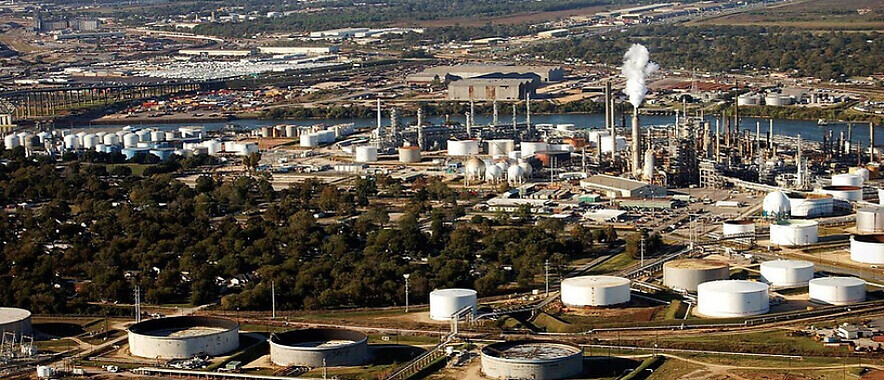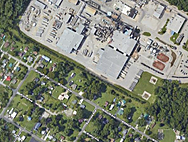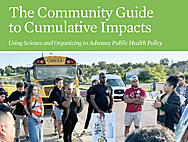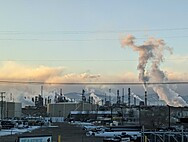Zero Emissions Whole Communities
Cumulative impacts are the combined chemical and non-chemical stressors on a community’s health, well-being and quality of life.
Federal agencies have the power to determine whether chemicals are safe, and whether the facilities that produce them are safe. But right now, regulators aren’t seeing the big picture. When we regulate chemical pollution, we can’t just think about the safety of one chemical or one facility at a time. Instead, we have to think about the health of a community holistically. Is a community being exposed to lots of different toxic chemicals from a cluster of facilities? What happens when people breathe, drink, or are exposed to these chemicals in combination? Is public health already stressed in this community, and why? For example, are cancer and asthma rates higher than average in this community? Has this community faced systematic racial discrimination, by being targeted for highway construction and industrial development, or being shut out of home loans via redlining policies? Are there accessible and quality hospitals, grocery stores and green spaces in this community?
By looking at cumulative impacts, we are able to see which communities have been harmed the most, and must be restored, strengthened and repaired.
About us
 We are a collaborative working group of the Coming Clean network. We support and mobilize environmental organizations and directly impacted community members to speak and submit comments to the EPA and other governmental agencies tasked with regulating pollution, to ensure that these bodies hear from people most affected by new methods and policies, listen to their concerns and implement their recommendations. Our long-term goals are to reduce harm from cumulative impacts and to require mandatory emissions reductions, in alignment with the Louisville Charter for Safer Chemicals.
We are a collaborative working group of the Coming Clean network. We support and mobilize environmental organizations and directly impacted community members to speak and submit comments to the EPA and other governmental agencies tasked with regulating pollution, to ensure that these bodies hear from people most affected by new methods and policies, listen to their concerns and implement their recommendations. Our long-term goals are to reduce harm from cumulative impacts and to require mandatory emissions reductions, in alignment with the Louisville Charter for Safer Chemicals.
Get involved
If you are a member, send an email to Kathy Curtis (see directory) to ask about current action opportunities, how to join our bi-weekly meetings, and learn more about our work! If you are not yet a member, email Jamie Irby jirby@comingcleaninc.org to inquire.
Research from the Coming Clean network
 The Community Guide to Cumulative Impacts is a resource to help community, statewide, and national organizing, research, and campaigns drive changes that protect us from cumulative chemical and pollution harms—especially in disproportionately impacted and overburdened communities. You can use its overview of proven strategies and tools to organize your community. You can learn from trailblazing grassroots community advocates across the United States as you introduce and advance local policies on cumulative impacts. Understanding cumulative impacts as both a concept and a policy strategy will strengthen your capacity to take action in your community or state.
The Community Guide to Cumulative Impacts is a resource to help community, statewide, and national organizing, research, and campaigns drive changes that protect us from cumulative chemical and pollution harms—especially in disproportionately impacted and overburdened communities. You can use its overview of proven strategies and tools to organize your community. You can learn from trailblazing grassroots community advocates across the United States as you introduce and advance local policies on cumulative impacts. Understanding cumulative impacts as both a concept and a policy strategy will strengthen your capacity to take action in your community or state.
 Addressing Environmental Injustice Through the Adoption of Cumulative Impacts Policies: A 2021 Louisville Charter Policy Brief by Drs. Nicky Sheats and Ana Baptista defines cumulative impacts and highlights model policies to address them, with a focus on New Jersey state legislation.
Addressing Environmental Injustice Through the Adoption of Cumulative Impacts Policies: A 2021 Louisville Charter Policy Brief by Drs. Nicky Sheats and Ana Baptista defines cumulative impacts and highlights model policies to address them, with a focus on New Jersey state legislation.
 Environmental Justice for Delaware Mitigating Toxic Pollution in New Castle County Communities: A 2017 report by the Union of Concerned Scientists, EJHA, Delaware Concerned Residents for Environmental Justice, Coming Clean and partners, shows that EJ communities in Delaware face substantial cumulative health risks from exposure to toxic air pollution that are much greater than those faced by wealthy white neighborhoods.
Environmental Justice for Delaware Mitigating Toxic Pollution in New Castle County Communities: A 2017 report by the Union of Concerned Scientists, EJHA, Delaware Concerned Residents for Environmental Justice, Coming Clean and partners, shows that EJ communities in Delaware face substantial cumulative health risks from exposure to toxic air pollution that are much greater than those faced by wealthy white neighborhoods.

Life at the Fenceline: Understanding Cumulative Health Hazards in Environmental Justice Communities A 2015 report by Coming Clean and EJHA shows that people on the fenceline live under the threat of chemical disasters, have limited access to healthy food, and experience higher rates of cancer and respiratory illness.






